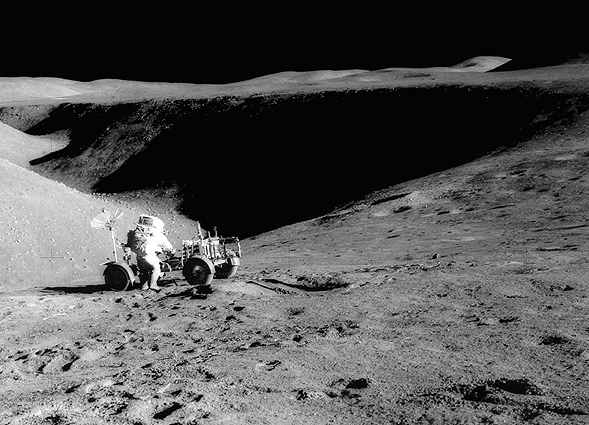The most visually dramatic Apollo landing site was Apollo 15 - on the edge of Hadley Rille and almost in the shadow of the Apennine Mountains. The goal of that mission was to seek information on how both of these features formed. This was also the first Apollo mission with a Rover so astronauts Scott and Irwin could travel close to both structures - although it would be a long walk back if they had a flat tire! Telephoto images of the Apennines revealed layering that probably represents original flat-lying rocks from the target that were uplifted and tilted backward by the Imbrium collision, 3.85 billion years ago. Close-up images of the insides of the Hadley rille also showed layering. This probably represents different layers of lava that the rille had cut down through. The rille itself is a lava channel or collapsed lava tube. I had watched tubes and channels form in Hawaii and had co-authored a paper in 1971 comparing Hawaiian lava tubes and lunar rilles. Lava channels distribute lava from a source vent, with surges of lava overflowing and spreading sideways. Intense small scale cratering since these lavas flowed 3.3 b.y. ago has destroyed the original lava surface.
Related Links:
Hadley Rille from orbit (from my volcano web site)
Hadley Rille painted by Alan Bean
Hadley Rille transcript
Lunar Rilles and Hawaiian Volcanic Features: Possible Analogs. DP Cruikshank and CA Wood. The Moon 3, 412-447; 1972.
|
Yanvar' Fevral' Mart Aprel' Mai Iyun' Iyul' Avgust Sentyabr' Oktyabr' Noyabr' Dekabr' |
|
Publikacii s klyuchevymi slovami:
Moon - Luna - Lunar Photo of the Day - LPOD
Publikacii so slovami: Moon - Luna - Lunar Photo of the Day - LPOD | |
Sm. takzhe:
Vse publikacii na tu zhe temu >> | |
